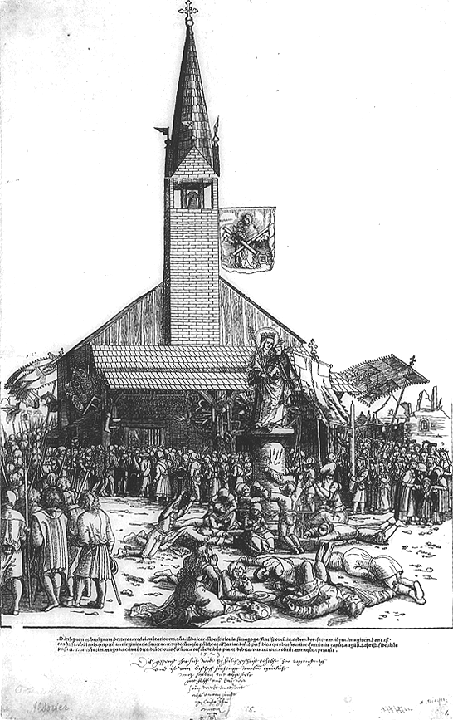 The Pilgrimage to
the Shrine of the Beautiful Virgin, Regensburg, 1519.
The Pilgrimage to
the Shrine of the Beautiful Virgin, Regensburg, 1519.
This woodcut by Michael Ostendorfer (?-1549), depicts the mass pilgrimage to the shrine of the Beautiful Virgin (Schöne Maria) in the imperial city of Regensburg. The event it decribes encapsulates some of the more spectacular characteristics of late popular religion: its explosive spontaneity, for example, the shift in pilgrimage practice away from solitary treks to distant places toward mass gatherings at nearby shrines, the reorientation of popular devotion toward universalizing symbols of Christian belief, such as the Virgin Mary or the Bleeding Host. This particular shrine was also linked to popular antisemitism: the shrine of the Beautiful Virgin was built on the former site of a synagogue, destroyed when Regensburg expelled its Jewish population in 1519. Soon after the chapel was built, word spread that miracles had occured there, and as Ostendorfer's woodcut suggests, it quickly became an immensely popular destination for pilgrims. A contemporary description gives some impression of it popularity:
'In 1516, a learned doctor, Balthasar Hubmaier preached so vigorously against the Jews, that with permission of the Emperor, the city council drove them out. Some of the Jew's houses were confiscated by Christians. Others were destroyed like their synagogue. On the place of their synagogue a church dedicated to the Virgin Mary was built. A spontaneous pilgrimage began. All sorts of people came, some with musical instruments, some with pitchforks and rakes; women came with their milk cans, spindles and cooking pots. Artisans came with their tools: a weaver with his shuttle, a carpenter with his square, a cooper with his measuring tape. They walked many miles, but did not tire from the long journey. They all walked in silence. If asked why there were going, they answered: "My spirit drives me there"[1]The Regensburg shrine was by no means exceptional: during the half century before 1520, shrines to the Virgin Mary, in particular, had enjoyed enormous popularity. Hubmaier, incidentally, emerged a few years later as a major figure on the radical edge of Reformation.